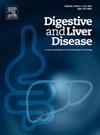斑点跟踪超声心动图评价等待肝移植患者左心房功能障碍
IF 3.8
3区 医学
Q1 GASTROENTEROLOGY & HEPATOLOGY
引用次数: 0
摘要
移植前心脏评估对于确定患者有围手术期和术后心血管并发症风险至关重要。先进的超声心动图,特别是左心房应变(LAS)分析,提供了一个敏感的评估心房功能,这并不总是检测到传统的超声心动图参数。本研究的目的是评估高级超声心动图值(如左心房应变)在原位肝移植(OLT)患者风险分层和了解心脏病理生理方面的临床应用。方法对41例连续等待OLT的患者进行回顾性观察性研究。患者队列平均年龄为58±10岁,其中14.6%为女性。肝病病因方面,36.6%为病毒性病因,29.3%为MASLD, 39.0%为酒精相关性肝硬化。48.8%(20例)有HCC作为OLT指征。MELD评分中位数为16 (IQR: 12), MELD- na评分中位数为17 (IQR: 14)。所有患者均行全面超声心动图评估,包括斑点跟踪超声心动图评估左心房纵向应变参数:la -应变库(LASr) 35.8%±10.3(正常值>;39%), la -应变导管(LAScd) 19.6%±7.3(正常值15-25%),la -应变收缩(LASct) 16.5±6.9(正常值17-19%)。移植后第一个月的随访数据也被记录下来。结果左心房应变与肝病严重程度有显著相关性。其中,LASct与OLT评估时MELD评分呈显著负相关(r = -0.832,p = 0.010),与Na-MELD评分呈显著负相关(r = -0.850,p = 0.008)。这些结果表明,较高的MELD评分与左心房收缩功能的显著恶化有关。随访期间,4例(9.8%)患者发生早期心血管事件(olt后1个月):Tako-tsubo 1例,心源性猝死1例,房颤1例,急性心肌梗死1例。在有事件与无事件患者的比较分析中,LASr与无事件患者相比差异有统计学意义(p = 0.023)。结论作为左房收缩力指标的LASct与晚期肝病的严重程度密切相关。此外,LASr作为左心房扩张和充盈的指标,可能是这类患者特定心血管并发症的早期危险指标,因此具有预后作用。本文章由计算机程序翻译,如有差异,请以英文原文为准。
Assessment of Left Atrial Dysfunction Using Speckle Tracking Echocardiography in Patients Awaiting Liver Transplant
Introduction
Pre-transplant cardiac evaluation is crucial for identifying patients at risk of peri- and post-operative cardiovascular complications. Advanced echocardiography, particularly left atrial strain (LAS) analysis, offers a sensitive assessment of atrial function, which is not always detectable with conventional echocardiographic parameters. The aim of this study is to evaluate the clinical utility of advanced echocardiographic values, such as left atrial strain, in risk stratification and understanding cardiac pathophysiology in patients undergoing orthotopic liver transplant (OLT).
Methods
A retrospective observational study was conducted, including 41 consecutive patients awaiting OLT. The patient cohort had a mean age of 58 ± 10 years, with 14.6% being female. Regarding the etiology of liver disease, 36.6% had viral etiology, 29.3% had MASLD, and 39.0% had alcohol-related cirrhosis. 48.8% (20 patients) had HCC as an OLT indication. The median MELD score was 16 (IQR: 12), and the median MELD-Na score was 17 (IQR: 14). All patients underwent comprehensive echocardiographic evaluation, including assessment of left atrial longitudinal strain parameters using Speckle Tracking Echocardiography: LA-Strain Reservoir (LASr) 35.8% ± 10.3 (normal value >39%), LA-Strain Conduit (LAScd) 19.6% ± 7.3 (normal value 15-25%), and LA-Strain Contractile (LASct) 16.5 ± 6.9 (normal value 17-19%). Follow-up data were also recorded during the first month post-transplant.
Results
Correlation analyses revealed significant relationships between left atrial strain and the severity of liver disease. In particular, LASct showed a strong, statistically significant negative correlation with the MELD score at the time of OLT evaluation (r = -0.832, p = 0.010) and with the Na-MELD score (r = -0.850, p = 0.008). These results indicate that higher MELD scores are associated with significant deterioration of left atrial contractile function. During the follow-up period, 4 patients (9.8%) developed early cardiovascular events (<1 month post-OLT): 1 case of Tako-tsubo, 1 sudden cardiac death, 1 atrial fibrillation, and 1 acute myocardial infarction. In the comparative analysis between patients with events and those without events, LASr showed a statistically significant difference (p = 0.023) compared to patients without events.
Conclusions
These data suggest that LASct, an indicator of left atrial contractility, is closely correlated with the severity of advanced liver disease. Furthermore, LASr, an indicator of left atrial distensibility and filling, could be an early risk indicator for specific cardiovascular complications in this type of patient, thus having a prognostic role.
求助全文
通过发布文献求助,成功后即可免费获取论文全文。
去求助
来源期刊

Digestive and Liver Disease
医学-胃肠肝病学
CiteScore
6.10
自引率
2.20%
发文量
632
审稿时长
19 days
期刊介绍:
Digestive and Liver Disease is an international journal of Gastroenterology and Hepatology. It is the official journal of Italian Association for the Study of the Liver (AISF); Italian Association for the Study of the Pancreas (AISP); Italian Association for Digestive Endoscopy (SIED); Italian Association for Hospital Gastroenterologists and Digestive Endoscopists (AIGO); Italian Society of Gastroenterology (SIGE); Italian Society of Pediatric Gastroenterology and Hepatology (SIGENP) and Italian Group for the Study of Inflammatory Bowel Disease (IG-IBD).
Digestive and Liver Disease publishes papers on basic and clinical research in the field of gastroenterology and hepatology.
Contributions consist of:
Original Papers
Correspondence to the Editor
Editorials, Reviews and Special Articles
Progress Reports
Image of the Month
Congress Proceedings
Symposia and Mini-symposia.
 求助内容:
求助内容: 应助结果提醒方式:
应助结果提醒方式:


